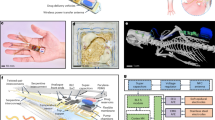Abstract
Thermochron iButtons are being used increasingly by animal physiologists to measure long-term patterns of body temperature in reptiles, birds and mammals. Typically, iButtons are surgically implanted into the intraperitoneal cavity where they measure and store body temperature together with the date and time from an onboard real-time clock. In 16-bit resolution, the DS1922L iButton can store a total of 4,096 data points over pre-determined sampling intervals. iButtons have proved invaluable in measuring patterns of torpor and hibernation in animals larger than 70 g. Weighing around 3.5 g after potting with wax, iButtons are too heavy and large to implant into animals smaller than 70 g because their weight exceeds 5% of the animal’s total body weight. This paper describes how the stainless steel canister housing the DS 1922L iButton battery and circuit board can be removed to reduce the weight of the components to 1.49 g after waxing (ready for implantation) without compromising the function or battery life of the iButton. The modified iButton can be implanted into animals as small as 20–30 g. Calibration data revealed an offset of ca. 1°C on average, confirming that iButtons must be calibrated prior to implantation.





Similar content being viewed by others
References
Brown KJ, Downs CT (2006) Seasonal patterns of body temperature of free-ranging rock hyrax (Procavia capensis). Comp Biochem Physiol A 143:42–49
Bulté G, Blouin-Demers G (2008) Northern map turtles (Graptemys geographica) derive energy from the pelagic pathway through predation on zebra mussels (Dreissena polymorpha). Freshw Biol 53:497–508
Davidson AJ, Aujard F, London BMM, Block GD (2003) Thermochron iButtons: an inexpensive method for long-term recording of core body temperature in untethered animals. J Biol Rhythms 18:430–432
Geiser F, Holloway JC, Körtner G (2007) Thermal biology, torpor and behaviour in sugar gliders: a laboratory-field comparison. J Comp Physiol B 177:495–501
Kinahan AA, Inge-moller R, Kotze A, Scantlebury M (2007) Body temperature daily rhythm in African savanna elephants (Loxodonta africana). Physiol Behav 92:560–565
Laurila M, Hohtola E (2005) The effect of ambient temperature and simulated predation risk on fasting-induced nocturnal hypothermia of pigeons in outdoor conditions. J Therm Biol 30:392–399
Lovegrove BG (2003) The influence of climate on the basal metabolic rate of small mammals: a slow-fast metabolic continuum. J Comp Physiol B 173:87–112
Lovegrove BG, Génin F (2008) Torpor and hibernation in a basal placental mammal, the lesser hedgehog tenrec Echinops telfairi. J Comp Physiol B 178:691–698
Lovegrove BG, Heldmaier G (1994) The amplitude of circadian body temperature rhythms in three rodents (Aethomys namaquensis, Thallomys paedulcus and Cryptomys damarensis) along an arboreal-subterranean gradient. Aust J Zool 42:65–78
Lovegrove BG, Heldmaier G, Knight M (1991) Seasonal and circadian energetic patterns in an arboreal rodent, Thallomys paedulcus, and a burrow-dwelling rodent, Aethomys namaquensis, from the Kalahari Desert. J Therm Biol 16:199–209
Masaki M, Koshimoto C, Tsuchiya K, Nishiwaki A, Morita T (2005) Body temperature profiles of the Korean field mouse Apodemus peninsulae during winter aggregation. Mammal Study 30:33–40
Mzilikazi N, Lovegrove BG (2004) Daily torpor in free-ranging rock elephant shrews, Elephantulus myurus: a year-long study. Physiol Biochem Zool 77:285–296
Mzilikazi N, Lovegrove BG, Masters JC (2004) No evidence for torpor in a small African mainland primate: the lesser bushbaby, Galago moholi. In: Barnes BM, Carey HV (eds) Life in the cold: evolution, mechanisms, adaptation and application. Twelfth International Hibernation Symposium. Institute of Arctic Biology, Fairbanks, pp 29–40
Mzilikazi N, Masters JC, Lovegrove BG (2006) Lack of torpor in free-ranging southern lesser galagos, Galago moholi: ecological and physiological considerations. Folia Primatol 77:465–476
Robert KA, Thompson MB (2003) Reconstructing Thermochron iButtons to reduce size and weight as a new technique in the study of small animal thermal biology. Herpetol Rev 34:130–132
Scantlebury M, Lovegrove BG, Jackson CR, Bennett NC, Lutermann H (2008) Hibernation and non-shivering thermogenesis in the Hottentot golden mole (Amblysomus hottentottus longiceps). J Comp Physiol B 178:887–897
Seebacher F, Guderley H, Elsey RM, Trosclair PL (2003) Seasonal acclimatisation of muscle enzymes in a reptile (Alligator mississippiensis). J Exp Biol 206:1193–1200
Skinner JD, Chimimba CT (2005) Mammals of the Southern African Sub-region. Cambridge University Press, Cambridge
Superina M, Boily P (2007) Hibernation and daily torpor in an armadillo, the pichi (Zaedyus pichiy). Comp Biochem Physiol A 148:893–898
Taylor EN, DeNardo DF, Malawy MA (2004) A comparison between point- and semi-continuous sampling for assessing body temperature in a free-ranging ectotherm. J Therm Biol 29:91–96
Warnecke L, Withers PC, Schleucher E, Maloney SK (2007) Body temperature variation of free-ranging and captive southern bandicoots Isoodon obesulus (Marsupialia: Peramelidae). J Therm Biol 43:72–77
Acknowledgments
This research was financed by publications incentive grants from the University of KwaZulu-Natal Research Office. I am grateful to Mark Brown for assistance with maintaining the research animals, and Kerrileigh Lobban for assistance with surgery. Steve Johnson kindly took the photographs.
Author information
Authors and Affiliations
Corresponding author
Additional information
Communicated by G. Heldmaier.
Rights and permissions
About this article
Cite this article
Lovegrove, B.G. Modification and miniaturization of Thermochron iButtons for surgical implantation into small animals. J Comp Physiol B 179, 451–458 (2009). https://doi.org/10.1007/s00360-008-0329-x
Received:
Revised:
Accepted:
Published:
Issue Date:
DOI: https://doi.org/10.1007/s00360-008-0329-x




